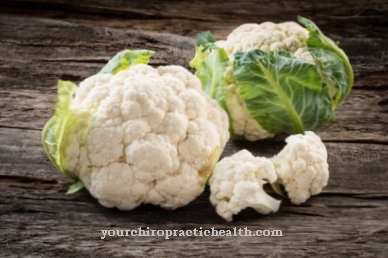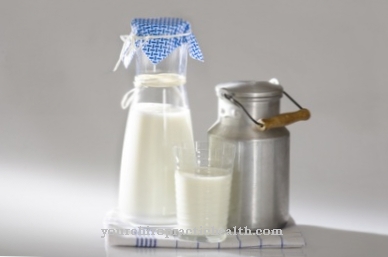Whipped cream decorates cakes and belongs on every coffee table. It is an important ingredient in pastry, ice cream and fine dining. Because it is high in calories, it was frowned upon for a long time. Fortunately, their reputation has improved again in recent years.
What you should know about whipped cream

Whipped cream must contain at least 30 percent fat, although there are also cream products with 35 percent fat and more. In Austria, whipped cream, which is comparable to whipped cream, always contains at least 36 percent fat. Whipped cream can be whipped with sugar or vanilla sugar, then the cream becomes “Crème Chantilly” in the kitchen language.
Whipped cream used to be the fatty part of milk that floated on top and could be skimmed off. Today, whipped cream is made from treated, skimmed milk that only has a fat content of 0.03 to 0.06 percent fat. The milk fat is then artificially measured out precisely. The special thing about milk fat is that it consists of small globules that are encased in a membrane made of proteins and phospholipids. This special shape enables the cream to be whipped into whipped cream. Hitting it creates huge air bubbles, but they get smaller the longer it is hit.
If the cream is whipped for too long, the air bubbles disappear completely and the cream becomes so firm that it is reminiscent of butter and can be used like butter. When the fat molecules are whipped, the membranes of the fat molecules are destroyed, they are then deposited around the air bubbles and in this way strengthen the firmness of the cream. Whipped cream was a very valuable food well into our time and was only used on festive days, by wealthy citizens and farmers and at the court. In a medieval recipe from Holland, whipped cream was first mentioned as an ingredient in waffles in the 16th century.
In general, whipping of the cream is considered to be a written guarantee from around 1650. According to legend, the crème Chantilly was invented at a feast for King Louis XIV in 1671, when the famous chef Francois Vatel sweetened the cream with sugar and vanilla. In 1750, the Crème Chantilly first appeared in a cookbook. As an ingredient in pastry shops, it did not establish itself until the end of the 19th century, when the cooling options were getting better and better.
Importance to health
Whipped cream is high in fat and high in calories, but it is lower in calories than is generally believed. A typical whipped cream with 30 percent fat has 286 calories per 100 grams. Higher fat cream can have up to 350 calories.
However, 100 grams of whipped cream is a considerable amount and will fill an entire cake plate! Whipped cream used to play a major role in the nutrition of malnourished children, they were literally "pepped up" with it. In general, the relationship with whipped cream has eased in recent years, when research showed that milk fats did not have a negative impact on cholesterol levels. However, since vitamins need fat to be soluble, a strawberry cake made with a tablespoon of whipped cream, which is estimated to be only 40 calories, can be much healthier than a cake without cream.
A vegetable soup can not only taste better with a dash of cream, but also gain in nutritional value, as the vitamins are more easily absorbed with fats. Whipped cream and cream are also considered rejuvenating. Even in ancient times, noble women bathed in milk because these baths made the skin particularly soft.Today women know that whipped cream immediately makes the skin of the face appear softer and smoother. Even after sunburn, cream has a refreshing and beneficial effect on the skin and promotes healing.
Ingredients & nutritional values
| Nutritional information | Amount per 100 gram |
| Calories 257 | Fat content 30 g |
| cholesterol 76 mg | sodium 8 mg |
| potassium 147 mg | carbohydrates 12 g |
| protein 3.2 g | Fiber 0 mg |
Whipped cream not only contains 30 grams of fat, it is also rich in vitamins and minerals. Whipped cream contains considerable amounts of vitamins A, B6, B12, D2 and C. In addition, like all dairy products, whipped cream contains large amounts of calcium, magnesium, sodium, potassium and iron.
D and B vitamins are considered to improve the mood, as they promote the production of messenger substances. Especially in the dark winter months, there can be a D-vitamin deficiency and winter depression. The intake of D vitamins can prevent this. Whipped cream therefore rounds off a vitamin-rich food. Whipped cream contains 138 mg of cholesterol per 100 grams, but this large amount has no negative impact on blood lipids and blood values.
Intolerances & allergies
Whipped cream can cause unpleasant reactions such as diarrhea, nausea, and rashes in people who are lactose intolerant. However, the proportion of milk sugar in whipped cream is very low, which means that even many lactose intolerant people can tolerate whipped cream and butter as one of the few dairy products.
These patients are even recommended to replace milk with cream, which is diluted with water before consumption and thus becomes lower in fat. Diluted cream is an excellent milk substitute! Some people also react to the high fat content of whipped cream. Bile and intestinal patients in particular can therefore suffer from nausea and pain after consuming whipped cream. If you get sick on cream and still don't want to do without it, you can now use soy cream substitutes.
Shopping & kitchen tips
Fresh whipped cream can turn sour after just a few hours without cooling, so it is important that the cold chain is interrupted as briefly as possible after shopping. On hot summer days, a cooler bag is recommended for transport home.
Otherwise, the expiry date on the packaging must be observed. Sour whipped cream is not necessarily bad, it can also be processed further in the kitchen as “sour cream”. In the supermarkets, whipped cream is also offered, which has been made long-lasting through a special heating process. This whipped cream can also be stored outside the refrigerator, but after the expiry date it is not “sour cream” that can be further processed. It then has to be disposed of.
Preparation tips
Whipped cream works best when it's well chilled. The bowl and whisk should also be chilled. If you hit with your hand, it is best to use the figure eight. The stirring movement should be in the shape of a figure eight. Then the cream will set the fastest! A hand mixer, on the other hand, is first set to a low level and then slowly increased.
With a hand mixer it can very quickly happen that the cream is whipped too long and gets the consistency of butter. The whipped cream will hold its shape if a little sugar or vanilla sugar is added. In an emergency, cream stabilizer can also be used. Cream siphons are particularly practical. The cream becomes one hundred percent stiff and can then be stored in the refrigerator in the siphon for a few days.
























.jpg)



